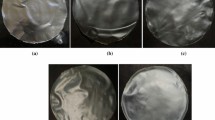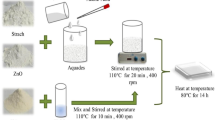Abstract
Synthetic plastic is the most anxious polymer in packing industry due to its non-biodegradability and biogeomagnification in the ecosystem. In light of the growing worldwide concern over synthetic polymers, natural and semi-synthetic biodegradable packaging materials with microbicide properties are receiving more attention in the food industry. The current research emphasises on the idea to convert a waste aquatic weed in to an advantageous eco-friendly substitute to a harmful biomagnifying food packing material. Water weed Eichhornia crassipes was used for the formation of hybrid films with nanocellulose and nanoclay coupled with green synthesised zinc oxide nanoparticles (NPs) by C. fistula fruit extract. Physicochemical properties of the starch-based binary nanocomposite (BNC) as well as ternary nanocomposite (TNC) were confirmed by TGA, DSC, SEM, EDX, FTIR and XRD analyses. The mechanical properties of both BNC and TNC were evaluated for its tensile strength, Young’s modulus and elongation break analysis. Further, the established ternary nanocomposite film with 2% ZnO NPs showed better surface morphology compared to the control binary films. Microbial efficacy studies revealed that the synthesised films are microbicidal in nature against foodborne pathogens Escherichia coli, Botrytis cinerea and Sclerotium rolfsii. The overall study accentuates that the green-based nanocomposites are eco-friendly, economically feasible and act as an effective route to overcome foodborne pathogens conferring them to be an alternative to petrochemical-based product.










Similar content being viewed by others
Explore related subjects
Discover the latest articles, news and stories from top researchers in related subjects.Data availability
Not applicable.
References
Priya ESP, Selvan PS (2017) Water hyacinth (Eichhornia crassipes)—An efficient and economic adsorbent for textile effluent treatment—a review. Arab J Chem 10:s3548–s3558
Xiao S, Qi D, QuanFa Z, WeiBo W (2015) Comparative responses of two water hyacinth (Eichhornia crassipes) cultivars to different planting densities. Aquat Bot 121:1–8
Dai H, Ou S, Liu Z, Huang H (2017) Pineapple peel carboxymethyl cellulose/polyvinyl alcohol/mesoporous silica SBA-15 hydrogel composites for papain immobilization. Carbohyd Polym 169:504–514
Thiripura SM, Ramesh A (2012) Isolation and characterization of cellulose nanofibers from the aquatic weed water hyacinth—Eichhornia crassipes. Carbohydr polym 87(2):1701–1705
Oliveira JP, Bruni GP, Lima KO, Halal SLME, Rosa GSD, Dias ARG, Zavareze EDR (2017) Cellulose fibers extracted from rice and oat husks and their application in hydrogel. Food Chem 221:153–160
Titik I, Nur R, Richa R, Metty M, Slamet P, Heru S (2015) Cellulose isolation from tropical water hyacinth for membrane preparation. Procedia Environ Sci 23:274–281
Agustin M, Ahmmad B, Alonzo SMM, Patriana FM (2014) Bioplastic based on starch and cellulose nanocrystals from rice straw. J Reinf Plast Compos 33(24):2205–2213
M.B. Agustin, R.P.Enna, L. De, L.B.Jerico, S.M.M. Alonzo, F.M. Patriana, H.Fumihiko, B.Ahmmad B, Starch based bioplastics reinforced with cellulose nanocrystals from agricultural residues. International Conference on Advances in Engineering and Technology (ICAET'2014), Singapore. 593–597 (2014).
Narancic T, Federico C, Niall B, O’Connor KE (2020) Recent advances in bioplastics: application and biodegradation. Polymers 12(4):920
Chukwuma SE, Temitope DF (2018) Trends on bio-synthesis of plastics. Adv Biotech & Micro 10(5):555797
Gaspar M, Benko Z, Dogossy G, Reczey K, Czigany T (2005) Reducing water absorption in compostable starch-based plastics. Polym Degrad Stab 90:563–569
Joshi S (2008) Can nanotechnology improve the sustainability of biobased products? the case of layered silicate biopolymer nanocomposites. J Ind Ecol 12:474–489
Cyras VP, Soledad CM, Analía V (2009) Biocomposites based on renewable resource: acetylated and non-acetylated cellulose cardboard coated with polyhydroxybutyrate. Polymer 50:6274–6280
Loh GH, Nor YY, Zawawi EZE (2021) Review of bioplastics as food packaging materials. AIMS Mater Sci 8(2):166–184
Seena KT, Jyotishkumar P, Senthilkumar K, SaburaBegum PM (2021) A comprehensive review on cellulose, chitin, and starch as fillers in natural rubber biocomposites. Carbohydr Polym Technol Appl 2:100095
Julkapli NM, Bagheri S (2017) Progress on nanocrystalline cellulose biocomposites. React Funct Polym 112:9–21
Noshirvani N, Hong W, Ghanbarzadeh B, Fasihi H, Montazami R (2018) Study of cellulose nanocrystal doped starch-polyvinyl alcohol bionanocomposite films. Int J Biol Macromol 107:2065–2074
Li JL, Zhou M, Cheng G, Cheng F, Lin Y, Zhu PX (2019) Comparison of mechanical reinforcement effects of cellulose nanofibers and montmorillonite in starch composite. Starch-Stärke 71(1–2):1800114
Gutierrez TJ, Alvarez VA (2017) Cellulosic materials as natural fillers in starch-containing matrix-based films: a review. Polym Bull 74:2401–2430
Infurna G, Cavallaro G, Lazzara G, Milioto S, Dintcheva NT (2020) Bionanocomposite films containing halloysite nanotubes and natural antioxidants with enhanced performance and durability as promising materials for cultural heritage protection. Polymers 12:1973
Makaremi M, Pasbakhsh P, Cavallaro G, Lazzara G (2017) Effect of morphology and size of halloysite nanotubes on functional pectin bionanocomposites for food packaging applications. ACS Appl Mater Interfaces 9(20):17476–17488. https://doi.org/10.1038/s41598-020-65949-3
Bumbudsanpharoke N, Choi J, Ko S (2015) Applications of nanomaterials in food packaging. J Nanosci Nanotechnol 15(9):6357–6372
Dash KK, Deka P, Bangar SP, Chaudhary V, Trif M, Rusu A (2022) Applications of Inorganic nanoparticles in food packaging: a comprehensive review. Polymers 14:521
Kumar S, Mudai A, Roy B, Basumatary IB, Mukherjee A, Dutta J (2020) Biodegradable Hybrid Nanocomposite of Chitosan/Gelatin and Green Synthesized Zinc Oxide Nanoparticles for Food Packaging. Foods 9:1143
Asma MT, Javed IM, Jyothi A (2022) Study of induced amplification of antibacterial activity of ciprofloxacin on coupling with ZnO nanoparticles (ZnONp). Mater Today: Proc 49(3):632–637
Ibrahim MIJ, Sapuan SM, Zainudin ES, Zuhri MYM (2019) Extraction, chemical composition, and characterization of potential lignocellulosic biomasses and polymers from corn plant parts. BioResources 14:6485–6500
Franco CR, Cyras VP, Busalmen JP, Ruseckaite RA, Vazquez A (2004) Treated Degradation of polycaprolactone/starch blends and composites with sisal fibre. Polym Degrad Stab 86:95e103
Peighambardoust SJ, Peighambardoust SH, Pournasir N, Pakdel PM (2019) Properties of active starch-based films incorporating a combination of Ag, ZnO and CuO nanoparticles for potential use in food packaging applications. Food Packag Shelf Life 22:100420
Vanti GL, Kurjogi M, Basavesha KN, Teradal NL, Masaphy S, Nargund VB (2020) Synthesis and antibacterial activity of solanum torvum mediated silver nanoparticle against Xanthomonas axonopodis pv. punicae and Ralstonia solanacearum. J Biotechnol 309:20–28
Vanti GL, Masaphy S, Kurjogi M, Chakrasali S, Nargund VB (2020) Synthesis and application of chitosan-copper nanoparticles on damping off causing plant pathogenic fungi. Int J Biol Macromol 156:1387–1395
Vincent JM (1947) Distortion of fungal hyphae in the presence of certain inhibitors. Nature 159:850
Jain S, Mehata MS (2017) Medicinal plant leaf extract and pure flavonoid mediated green synthesis of silver nanoparticles and their enhanced antibacterial property. Sci Rep 7(1):15867
Das D, Nath BC, Phukon P, Dolui SK (2013) Synthesis and evaluation of antioxidant and antibacterial behavior of CuO nanoparticles. Coll Surf B Biointerfaces 101:430–433
Kalpana H, Bhavsar S, Horne A, Chhattise P, Mohite K (2014) Novel green route of synthesis of ZnO nanoparticles by using natural biodegradable polymer and its application as a catalyst for oxidation of aldehydes. J Macromol Sci Part A Pure Appl Chem 51(12):941–947
Kalpana VN, DeviRajeswari V (2018) A review on green synthesis, biomedical applications, and toxicity studies of ZnO NPs. Bioinorg Chem Appl. https://doi.org/10.1155/2018/3569758
Chandra J, George N, Narayanankutty SK (2016) Isolation and characterization of cellulose nanofibrils from arecanut husk fibre. Carbohyd Polym 142:158–166
Janoobi M, Harun J, Shakeri A, Misra M, Oksman K (2009) Chemical composition, crystallinity, and thermal degradation of bleached and unbleached kenaf bast. BioRes 4(2):626–639
Nacos MK, Katapodis P, Pappas C, Daferera D, Tarantilis PA, Christakopoulos P, Polissiou M (2006) Kenaf xylan—a source of biologically active acidic oligosaccharides. Carbohydr Polym 66(1):126–134
Wahyuningtiyas NE, Suryanto H (2018) Properties of cassava starch based bioplastic reinforced by nanoclay. Journal of Mechanical Engineering Science and Technology (JMEST) 2(1):20–26
Gao Y, Li D (2020) Preparation and characterization of corn composite films incorporated with ε-polylysine as a novel antimicrobial packaging material. E-Polymers 20(154):161. https://doi.org/10.1515/epoly-2020-0019
Zhang L, Zhao J, Zhang Y, Li F, Li Q (2021) The effects of cellulose nanocrystal and cellulose nanofiber on the properties of pumpkin starch-based composite films. Int J Biol Macromol 192:444–451
Al-Beladi AA, Kosa SA, Wahab RA, Salam MA (2020) Removal of orange G dye from water using halloysite nanoclay-supported ZnO nanoparticles. Desalin Water Treat 196:287–298
Hu X, Jia X, Zhi C, Jin Z, Miao M (2019) Improving the properties of starch-based antimicrobial composite fi lms using ZnO-chitosan nanoparticles. Carbohydr Polym 210:204–209
Vaezi K, Asadpour G, Sharifi H (2019) Effect of ZnO nanoparticles on the mechanical, barrier and optical properties of thermoplastic cationic starch/montmorillonite biodegradable films. Int J Biol Macromol 124:519–529
Torabi Z, Mohammadi Nafchi A (2013) The effects of SiO2 nanoparticles on mechanical and physicochemical properties of potato starch films. J Chem Health Risks 3:33–42
Nafchi AM, Nassiri R, Sheibani S, Ariffin F, Karim AA (2013) Preparation and characterization of bionanocomposite films filled with nanorod-rich zinc oxide. Carbohyd Polym 96(1):233–239
Abdullah AH, Putri O, Fikriyyah A, Nissa R, Hidayat S (2020) Harnessing the excellent mechanical, barrier and antimicrobial properties of zinc oxide (ZnO) to improve the performance of starch-based bioplastic. Polym Plast Technol Mater 59(12):1259–1267
Panjaitan N, Ulyarti U, Mursyid M, Nazarudin N (2019) Modification of yellow uwi starch (Dioscorea alata) using the precipitation method and its application for edible film. Andalas Agr Technol J 23(2):196–204
Abdollahi M, Alboofetileh M, Behrooz R, Rezaei M, Miraki R (2013) Reducing water sensitivity of alginate bio-nanocomposite film using cellulose nanoparticles. Int J Biol Macromol 54:166–173. https://doi.org/10.1016/j.ijbiomac.2012.12.016
Kyong LS, Gi SD, Ryoun YJ (2005) Degradation and rheological properties of biodegradable nanocomposites prepared by melt intercalation method. Fibers Polym 6(4):289–296
Stanic V, Dimitrijević S, Antić-Stanković J, Mitrić M, Jokić B, Plećaš IB, Raicevic S (2010) Synthesis, characterization and antimicrobial activity of copper and zinc-doped hydroxyapatite nanopowders. Appl Surf Sci 25:6083–6089
Acknowledgements
The authors thank Vision Group on Science and Technology, Bengaluru, Karnataka 560001, India, for their financial support (GRD No-984, under the scheme RGS/RGF) to carry out this research and Author also would like to thank Multidisciplinary Research Unit, Karnataka Institute of Medical Sciences Hubli, for providing support to carry out the studies.
Author information
Authors and Affiliations
Contributions
AMT and GLV conceived the study. AMT and JIM designed and conducted the experiments. GLV, JIM and ATM wrote the manuscript. BM helped to analyse results.
Corresponding author
Ethics declarations
Conflicts of interest
All contributing authors declare no conflicts of interest.
Ethical approval
Not applicable.
Additional information
Handling Editor: Stephen Eichhorn.
Publisher's Note
Springer Nature remains neutral with regard to jurisdictional claims in published maps and institutional affiliations.
Rights and permissions
Springer Nature or its licensor (e.g. a society or other partner) holds exclusive rights to this article under a publishing agreement with the author(s) or other rightsholder(s); author self-archiving of the accepted manuscript version of this article is solely governed by the terms of such publishing agreement and applicable law.
About this article
Cite this article
Tatagar, A.M., Moodi, J.I., Vanti, G.L. et al. Development of sustainable ternary bionanocomposite film reinforced with nanocellulose and nanoclay for microbial efficacy. J Mater Sci 59, 6334–6353 (2024). https://doi.org/10.1007/s10853-024-09568-7
Received:
Accepted:
Published:
Issue Date:
DOI: https://doi.org/10.1007/s10853-024-09568-7




